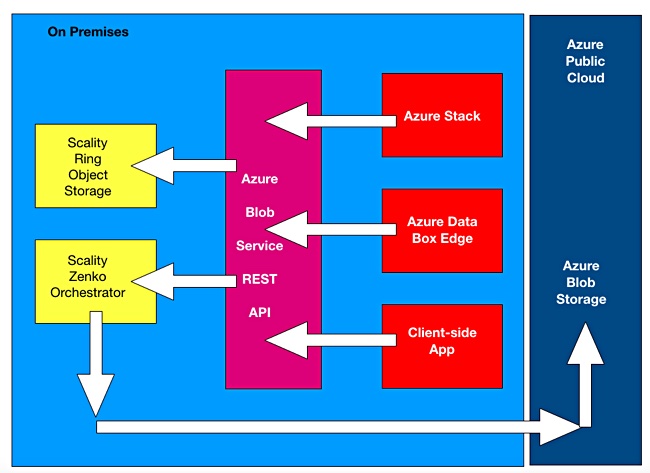Scality and Microsoft have teamed up to enable Scality’s RING object storage to accept data sent from Azure Stack Hub and Azure Stack Edge using the Azure Blob Service REST API. Zenko, Scality’s hybrid cloud data orchestrator tool, also supports this API.
Azure Stack Edge us the renamed Azure Data Box Edge and Azure Stack Hub is the renamed Azure Stack. Scality’s BlobServer is its implementation of the Azure Blob front end API and will be available as a public repository on Github, under an Apache 2.0 license, once the Azure Blob API-supporting RING and Zenko go GA.

Zenko can also use Azure’s public cloud Blob storage as back-end storage, completing the circle. Zenko is based on Scality’s implementation of the Amazon S3 API, aka S3 Server.
Tad Brockway, corporate VP for Azure Storage, Media and Edge at Microsoft, issued a supportive canned quote: “Customer interest in hybrid cloud and edge deployments is increasing, and we see a market need for Azure edge solutions with scale-out storage support. We are glad to see Scality enable their products to support Azure Blob storage for a range of hybrid cloud and edge storage use cases.”
Close to the Edge
Azure Stack and Azure Data Box Edge are ways to deploy Microsoft’s Azure public cloud services on premises: Both were originally conceived of as means to collect data on-premises and send it to Microsoft’s Azure public cloud.
However, as edge IT ideas have taken hold – with nearly every IT installation outside a central data centre now called an edge deployment – so have ideas about the need for local storage and processing.
Networking edge data to the public cloud for processing takes too long and costs too much because of the huge volumes involved. The better option is to process locally-stored data at the edge and send a post-process and small subset of data and results to the public cloud.
Users face having to support two public cloud object storage APIs: Amazon’s S3, which is effectively an object storage; and Azure’s Blob API. Soon, no doubt, there will be a third – Google Cloud object storage.
We need a super-cloud object storage API which combines all three – but doubt this is on the horizon as the public cloud suppliers are fierce competitors.







